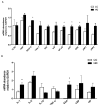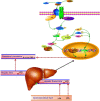Rumen-derived lipopolysaccharide provoked inflammatory injury in the liver of dairy cows fed a high-concentrate diet
- PMID: 28596485
- PMCID: PMC5564522
- DOI: 10.18632/oncotarget.18151
Rumen-derived lipopolysaccharide provoked inflammatory injury in the liver of dairy cows fed a high-concentrate diet
Abstract
Rumen-derived lipopolysaccharide (LPS) is translocated from the rumen into the bloodstream when subacute ruminal acidosis (SARA) occurs following long-term feeding with a high-concentrate (HC) diet in dairy cows. The objective of this study was to investigate the mechanism of inflammatory responses in the liver caused by HC diet feeding. We found that SARA was induced in dairy cows when rumen pH below 5.6 lasted for at least 3 h/d with HC diet feeding. Also, the LPS levels in the portal and hepatic veins were increased significantly and hepatocytes were impaired as well as the liver function was inhibited during SARA condition. Meanwhile, the mRNA expression of immune genes including TNF receptor associated factor 6 (TRAF6), nuclear factor-kappa B (NF-κB), p38 mitogen-activated protein kinase (MAPK), extracellular regulated protein kinases (ERK) MAPK, Interleukin-1 (IL-1) and serum amyloid A (SAA) in the liver were significantly increased in SARA cows. Moreover, the phosphorylation level of NF-κB p65 and p38 MAPK proteins in the liver and the concentration of Tumor Necrosis Factor (TNF-α), Interleukin-1β (IL-1β) and Interleukin-6 (IL-6) in peripheral blood were obviously increased under SARA condition. In conclusion, the inflammatory injury in the liver caused by LPS that traveled from the digestive tract to the liver through the portal vein after feeding with a HC diet.
Keywords: Immune response; Immunity; Immunology and Microbiology Section; dairy cows; inflammatory injury; lipopolysaccharide; liver; subacute ruminal acidosis.
Conflict of interest statement
The authors declare no conflicts of interest.
Figures







Similar articles
-
Inflammatory mechanism of Rumenitis in dairy cows with subacute ruminal acidosis.BMC Vet Res. 2018 Apr 19;14(1):135. doi: 10.1186/s12917-018-1463-7. BMC Vet Res. 2018. PMID: 29673406 Free PMC article.
-
Overfeeding with a high-concentrate diet activates the NOD1-NF-κB signalling pathway in the mammary gland of mid-lactating dairy cows.Microb Pathog. 2019 Mar;128:390-395. doi: 10.1016/j.micpath.2019.01.038. Epub 2019 Jan 28. Microb Pathog. 2019. PMID: 30703473
-
Lipopolysaccharide derived from the digestive tract triggers an inflammatory response in the uterus of mid-lactating dairy cows during SARA.BMC Vet Res. 2016 Dec 12;12(1):284. doi: 10.1186/s12917-016-0907-1. BMC Vet Res. 2016. PMID: 27955662 Free PMC article.
-
Diet-induced bacterial immunogens in the gastrointestinal tract of dairy cows: impacts on immunity and metabolism.Acta Vet Scand. 2011 Aug 9;53(1):48. doi: 10.1186/1751-0147-53-48. Acta Vet Scand. 2011. PMID: 21824438 Free PMC article. Review.
-
Integrating Subacute Ruminal Acidosis, Lipopolysaccharide, and Trained Immunity: A Comprehensive Review.Int J Biol Sci. 2025 Mar 31;21(6):2806-2823. doi: 10.7150/ijbs.104074. eCollection 2025. Int J Biol Sci. 2025. PMID: 40303309 Free PMC article. Review.
Cited by
-
High rumen degradable starch diet induced blood bile acids profile changes and hepatic inflammatory response in dairy goats.Anim Nutr. 2023 May 23;14:121-129. doi: 10.1016/j.aninu.2023.04.008. eCollection 2023 Sep. Anim Nutr. 2023. PMID: 37808950 Free PMC article.
-
Ameliorative effects of supranutritional selenium on TLR-4-NF-kB-TNF-α-mediated hepatic oxidative injury and inflammation in goats fed high concentrate diet.Food Sci Nutr. 2022 Jul 18;10(11):3842-3854. doi: 10.1002/fsn3.2980. eCollection 2022 Nov. Food Sci Nutr. 2022. PMID: 36348775 Free PMC article.
-
Impacts of Time-Fed Concentrate-Based Diets on Plasma Metabolites, Rumen Histology, and mRNA Expression of Hepatic Enzymes of Wethers.Animals (Basel). 2020 Apr 15;10(4):686. doi: 10.3390/ani10040686. Animals (Basel). 2020. PMID: 32326483 Free PMC article.
-
From Parts to Whole: A Systems Biology Approach to Decoding Milk Fever.Vet Sci. 2025 Apr 9;12(4):347. doi: 10.3390/vetsci12040347. Vet Sci. 2025. PMID: 40284849 Free PMC article. Review.
-
Dynamic interplay of immune response, metabolome, and microbiota in cows during high-grain feeding: insights from multi-omics analysis.Microbiol Spectr. 2024 Oct 3;12(10):e0094424. doi: 10.1128/spectrum.00944-24. Epub 2024 Aug 20. Microbiol Spectr. 2024. PMID: 39162517 Free PMC article.
References
-
- Krause KM, Oetzel GR. Understanding and preventing subacute ruminal acidosis in dairy herds: A review. Anim Feed Sci Tech. 2006;126:215–36. doi: 10.1016/j.anifeedsci.2005.08.004. - DOI
MeSH terms
Substances
LinkOut - more resources
Full Text Sources
Other Literature Sources
Miscellaneous

